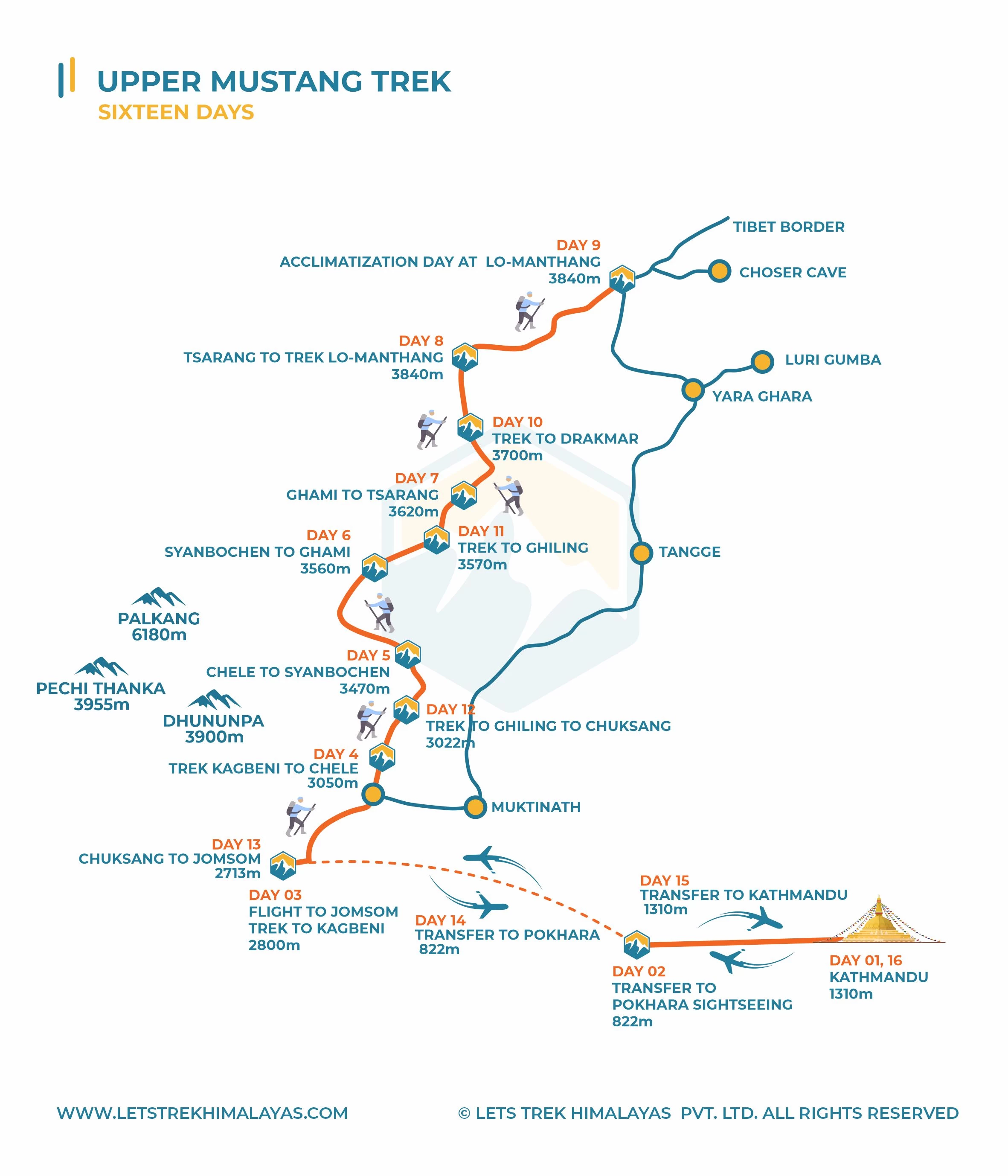Lead your way to the Kingdom of Mustang, an enclave of hidden Buddhism. Discover the hidden valley of Upper Mustang ruled by the Lo dynasty over the years in the cultural and historical city of the dune. far more capitalized for themselves in a hidden atmosphere like a desert concerned trekkers as the historical mythology and valley of the mystery.
The trans-Himalayan region bordering Tibet is characterized by arid terrain of high cliffs, unusual rock formations, and Duned colors: the people and culture here has a Tibetan feel. Delivers various caves, rock arts, lamasery, and gumbas, as well as a chance to learn about the culture of the region while admiring panoramic views of the Nilgiri, Annapurna, and Dhaulagiri mountains Upper Mustang Treks promises diversification.
A visit to the Upper Mustang is also a great way to learn more about the epoch-old Buddhist empire that mimics Tibet. Other highlights of the Upper Mustang trek include stunning mountain views, historic caverns, lovely monasteries, the Amchi Museum, vibrant walls, and prayer flags.
Without a doubt, Upper Mustang offers a special kind of beauty and glitz that no other trekking location in Nepal can. It is a rare gem for those looking for mystery and crafting mythological tales about the magical world.
As the trail travels through a stark landscape in the shadow of the Dhaulagiri berg, it visits Kagbeni: Gateway to Upper Mustang then goes on to Lo-Manthang, the historical seat of the Kingdom of Lo.
What to expect during Upper Mustang Trek
Trekkers weren't permitted to visit the area until the 1990s, Upper Mustang is also known as the Last Forbidden Kingdom. You may enjoy breathtaking views of the mountains, lush meadows, magnificent canyons, little towns, and other attractions in the Mustang region. Without the influence of contemporary lifestyles, people continue to live their traditional lives. You will undoubtedly be infatuated with the location due to the region's and its people's unique heritage and way of life.
However, this formerly "hidden kingdom" is evolving. The fundamental definition of a "trek" is being changed by the development of contemporary Chinese truck trade routes over old salt trade routes. With minimal regard for the ecology, roads plow straight over former trekking routes. Trekkers must endure inconvenience for at least a portion of their journey to Lo Manthang because of the long-lasting and slow construction.
Being a Dry River valley that runs north-south off the upper corner of the Annapurna Circuit. Upper Mustang Trekking destination is both socially and geologically used to shape its realm, with its capital in Lo Manthang (the circle back point of your journey). Lying in the downpour shadow of the Himalayas, and formally one of Nepal’s confined regions, known for its desert excellence and harsh, cliff-confronted geography.
Upper Mustang lies in the shadow of the Himalayas, making it an extraordinary rainstorm trek and open all year for traveling. The primary thought is the colder time of year when most inhabitants move to the city area to keep away from the cold and snow. For the most part, the best time to visit Upper Mustang is from March to early November.
Since the terrain is like a desert, growing crops and daily life could be difficult, right? But in Mustang the cultivations are smartly developed since humanity started to grow again. The specified areas near water sources coming from Mount Annapurna ranges are cultivated for sufficient production for people in Mustang.
Is Upper Mustang Trek appropriate for me?
The Upper Mustang Trek offers an exceptional chance to experience and comprehend the mountain the way of life in its unaltered nature. Geographic and diplomatic separation from the rest of the world has been essential in maintaining the region's unique culture, untouched natural resources, and historic elements of the centuries-old monastery.
The remnants of the medieval era, the vibrant prayer flags, and the riders on horses are strikingly distinct from modern civilization. Some of the eldest alpine tribe families in Mustang will allow you to contact them. You will also impart their legends and tales.
You'll be amazed by the enduring connection between people and mountains over time. Then a fresh tale is told by the royal palace, stunning ancient monasteries, the Amchi museum, and the Upper Mustang school.
With occasional off-road deviations, the Classic Route mostly stays on the road. Between Ghami and Lo Manthang, via Dhakmar and Ghar Gompa, the Western Route largely consists of an off-road portion that takes one to two days. It is advisable to tackle the Eastern Route on the way back because it is a 3-day (nearly fully) off-road track that connects Lo Manthang and Chhusang through Yara and Tangge. Instead of traveling by road to Kagbeni from Chhusang, one can hike on a path over the Gyu La to Muktinath. The Eastern Route, in our opinion, is the most scenic and difficult section of the entire walk.
Additionally, it offers close-up views of spectacular mountains including the Nilgiri Himal, Mt. Dhaulagiri, and Mt. Annapurna. Your breath will be taken away by the legendary village strolls as well as the enigmatic caverns, carvings, and historic monasteries.

